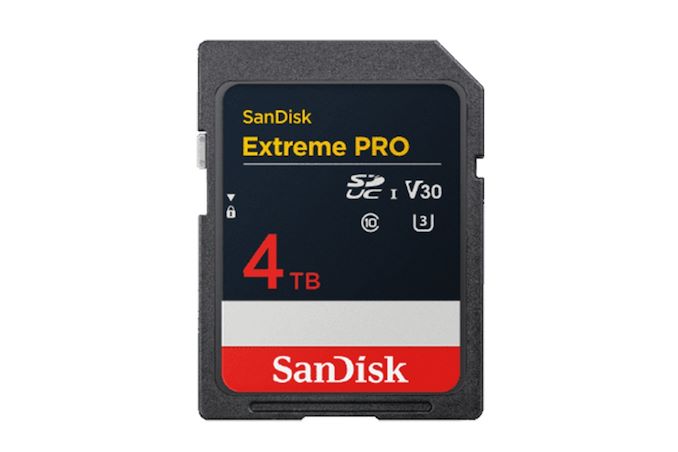Western Digital Previews 4 TB SD Card: World's Highest-Capacity
by Anton Shilov on April 11, 2024 6:30 PM EST- Posted in
- Storage
- Western Digital
- SanDisk
- SD cards
- SDUC

Western Digital this week is previewing the industry's first 4 TB SD card. The device is being showcased at the NAB trade show for broadcasters and content creators and will be released commercially in 2025.
Western Digital's SanDisk Extreme Pro SDUC 4 TB SD card complies with the Secure Digital Ultra Capacity standard (SDUC, which enables up to 128TB). The card uses the Ultra High Speed-I (UHS-I) interface and is rated for speed Class 10, therefore supporting a minimum speed of 10 MB/s and a maximum data transfer rate of 104 MB/s when working in UHS104 (SDR104) mode (there is a catch about performance, but more on that later). WD's SD card is also rated to meet Video Speed Class V30, supporting a minimal sequential write speed of 30 MB/s, which is believed to be good enough for 8K video recording, above and beyond the 4K video market that Western Digital is primarily aiming the forthcoming card at.
For now, Western Digital is not disclosing what NAND is in the SanDisk Extreme Pro SDUC 4 TB SD card. Given the high capacity and relatively distant 2025 release date, WD may be targetting this as one of their first products to use their forthcoming BiCS 9 NAND.
And while not listed in WD's official press release, we would be surprised if the forthcoming card didn't also support the off-spec DDR200/DDR208 mode, which allows for higher transfer rates than the UHS-I standard normally allows via double data rate signaling. Western Digital's current-generation SanDisk Extreme Pro SDXC 1 TB SD card already supports that mode, allowing it to reach read speeds as high as 170 MB/s, so it would be surprising to see the company drop it from newer products. That said, the catch with DDR208 remains the same as always: it's a proprietary mode that requires a compatible host to make use of.
Western Digital has not disclosed how much will its SanDisk Extreme Pro SDUC 4 TB SD card cost. A 1 TB SanDisk Extreme Pro card costs $140, so one can make guesses about the price of a 4 TB SD card that uses cutting-edge NAND.
Source: Western Digital










15 Comments
View All Comments
boozed - Sunday, April 14, 2024 - link
You can cram a lot of memory into a very small space if you're willing to give up speed and endurance. Replynandnandnand - Monday, April 15, 2024 - link
There's already a real 2 TB microsd card on the market, so a big 4 TB card is no surprise.As for M.2 2280, maybe 16 TB is on the way soon. Reply
back2future - Monday, April 15, 2024 - link
[ a difficulty with SD cards is, that with even TB of storage (sdxc 1TB(non standard 2TB), sduc up to 128TB, theoretically) there is no 'public/open source' monitoring tool (from my knowledge) for storage cells wear, like S.M.A.R.T standard for Sata/Pcie hdd&ssd (?)One has to rely on the controller (bridge) ic and even with durable nand, a controller ic can get pretty much temperature with up to ~3.85GB/s, while Uhs-II sd cards on a ~310MB/s might need ~2.8W (on bus speed mode HD312 (lower bus speed with SDR104/FD156) ), there are stacked controller&nand devices, also (?)
An advantage for sd cards is low standby consumption ~0.2mA. ] Reply
back2future - Monday, April 15, 2024 - link
[ 4TB=~4*1024²MB on 104MB/s results to ~11hrs for copying data to(&from?) sduc on SDR104 bus mode, for 170MB/s that's ~6.8hrs (?) ] ReplySchugy - Tuesday, April 16, 2024 - link
While the data density is impressive I'd still prefer to see availability of SDSDXFN-256G / SDSQXFN-256G SDExpress and MicroSDExpress cards. Reply